Astrolabe 28: That's why they call it a union.
The rise of the video game union, the secret best JRPG console, and a warm cappuccino under a harvest moon
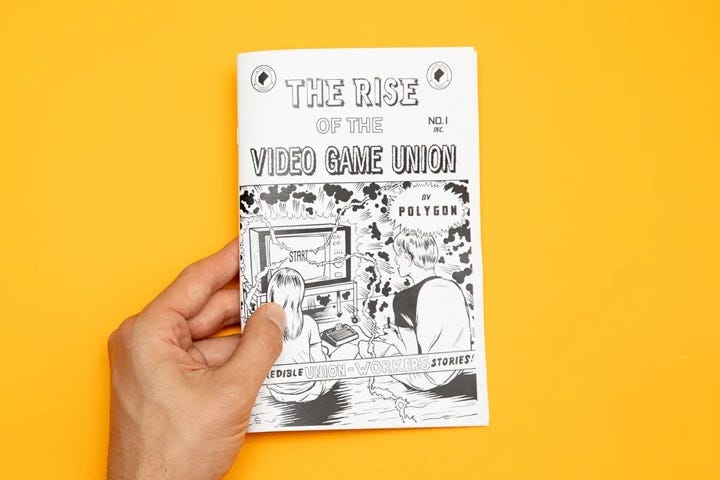
✊✊✊
Labour issues are obvious to anyone paying attention to the video game industry. Despite billions in profits every year, video game developers, artists, writers, quality assurance experts, and everyone else along the creative chain are expected to sacrifice their bodies, relationships, and lives to deliver unrealistic milestones on unsustainable deadlines. Layoffs, crunch, and studio closures are rampant, burnout inevitable.
For the industry to survive, and to ensure it can keep and support its valuable employees through their whole careers—instead of losing them to less demanding industries as they age out of the current exploitative system—something has to give when it comes to labour rights.
After decades of anti-union working environments dominated by capitalistic executives, video game creators are banding together to form unions at an impressive rate. It began in late 2021 when developer Vodeo successfully formed the industry’s first union in late 2021 (and then, sadly, shut down in September, 2022), followed by unions within companies like Keywords Studios, ZeniMax, Anemone Hug Interactive, and continued efforts at large multinationals like Microsoft and Activision.
As a journalist covering the games industry with a focus on labour issues, Polygon’s Nicole Carpenter (along with illustrator Van Saiyan and Designer William Joel) recently published “The Rise of the Video Game Union.” It's at once a historical accounting of why we're seeing a hot labour movement in the video game industry, and a how-to guide aimed at helping non-unionized workplaces begin the process of forming their own collective bargaining units.
“We've been covering worker organization and the build-up to this moment for years,” Carpenter told me when I reached out to chat about the zine and the labour movement, “and it made sense to bring all that reporting and gathered information together in one big place.”
Polygon’s goal1, she explained, was to approach this complex movement with an emphasis on transparency and ease-of-use. This led to the idea of producing an ‘80s-style zine in addition to the comprehensive online version. It took Carpenter nearly a year of reporting and interviews, during which time the industry continued to push toward unionization. “I spoke to dozens of video game industry workers,” she said, “and things kept continuing to progress over the year, so we knew we had something timely with it.”
“A union isn't actually a third party, it's the workers themselves.”
In Canada, where I live, you rarely run into anti-union sentiment, but it's a different story south of the border. As far as I'm concerned, anything billionaires spend their fortune fighting tooth-and-nail against must be beneficial to the greater good—so I’ve always struggled to understand why there’s any dissent among the working class in the United States.
It’s about power and maintaining the status quo at companies, Carpenter explained. “Corporations exist to create value and maximize profits for their shareholders,” she continued, “having a union could mean spending more money to fairly compensate workers with increased pay and benefits.”
Union busting is a common tactic used by corporations to stop their employees from unionizing (or to break up existing unions), and it can come it all shapes and sizes, according to Carpenter. “There are a number of different arguments that companies use to dissuade people from joining unions, citing things like high union dues or positioning a union as a third party.”
Carpenter’s guide anticipates this, though, and provides not only instruction for how to excite the workforce, but also how to recognize and fight back against union busting tactics. “A union isn't actually a third party, it's the workers themselves.”
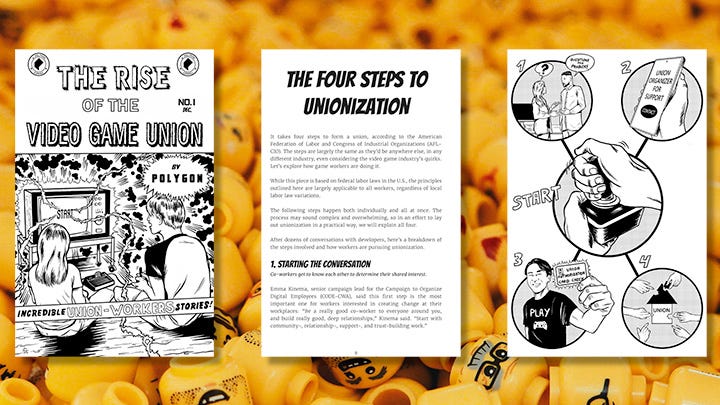
With the first gaming union just a year old, the industry is joining a litany of other industries—like publishing, journalism, and film/television—pushing back against predatory corporate interests through collective bargaining. But, gaming is still far behind those industries in terms of experience and volume of unions.
“The tech industry has a history of being against or slow to unionize,” said Carpenter. “Union experts I spoke to suggest it's because there are ingrained ideas on who unions are for, and a lot of people didn't previously see video game workers there. But that's changed a ton over the past few years as workers have seen the power of collective action in other organizing efforts, like the Riot Games walkout or the Lovestruck: Choose Your Romance strike.”
Unionization has broad benefits for not only the creators working on the games, but the players themselves. “The thing with unionization is that workers at any particular company get to negotiate with leadership for the things that will improve the workplace for themselves. [This] means better games by workers who aren't pushed to their limit everyday.”
While Carpenter and her colleagues report on labour issues in the games industry, her own field is rife with similar problems. Just this year, several prominent gaming publications (including IGN, Fanbyte, Vice, Polygon, and others) have experienced high profile layoffs. Some, like IGN and Carpenter’s Polygon, are protected by unions. Others aren’t. But the effect is just as stark: a higher volume of experienced writers vying for fewer jobs. (This also has a trickle down effect on freelance writers.)
Just this year:
— Carli Velocci (@velocciraptor) 8:38 PM ∙ Dec 8, 2022
- Polygon
- Game Informer
- Future
- G4TV
- Fanbyte
- Input
- Vice/Motherboard
- IGN
And more that I'm sure I'm forgetting.
(edited to add Vice)
Unionized media environments are a powerful tool to help balance out the scale of power against capitalistic goals of infinite growth at the expense of labour rights, but they’re not bullet proof.
“Everything feels so volatile regardless of whether a workplace is unionized or not,” admitted Carpenter, “but being in a union can absolutely help people feel more secure. Knowing your colleagues have your back, and in turn, having theirs, is really powerful—beyond what's in a contract, the solidarity there is very powerful. But having a contract is, of course, helpful, because that means protection in the event of layoffs, stuff like severance pay.”
"The Rise of the Video Game Union" isn't just a feature on Polygon's website, it's also an illustrated and printable zine designed for easy workplace distribution. This concept hearkens back to the fanzines/pamphlets that have been handed out as far back as the 16th century in support of political movements, artistic endeavours, and fan-created content. It's also a distribution method rarely seen in this digital age—which helps it reach a whole new audience, said Carpenter.
“We wanted the zine to live not only as a digital story, but for it to have a physical component that might be able to reach a different audience, people who aren't reading Polygon or spend so much time online,” she said. “I grew up making zines, both digitally and physically, and it felt really natural to do something like that, especially given the content.”
You can read “The Rise of the Video Game Union” on Polygon or view instructions for printing the fully-illustrated zine. Astrolabe will publish the full interview with Nicole Carpenter on Monday, December 12th for paid subscribers, and the following Monday for free subscribers.
Out & About
Out & About is where I highlight my work around the web—some recent and some old favourites.“Lost in Translation” on Unwinnable
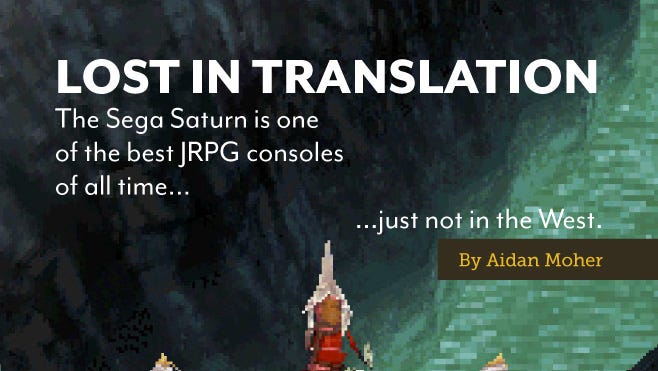
I’ve been a longtime fan of Unwinnable, who, for my money, put out some of the most interesting and engaging games writing out there, so it was a thrill to not only finally get to write for them, but to be the lead cover story for their November, 2022 issue! “Lost in Translation” explores a fascinating topic I didn’t have room in Fight, Magic, Items: Sega’s infamous flop, the Sega Saturn, is actually one of the best JRPG consoles of all time… just not in the west.
You can read the whole thing by purchasing the issue, or read an excerpt (linked below) on their website.
Here’s a sneak peek:
When you think of the Japanese RPG golden age, it recalls the 16-bit era, led by Nintendo’s vast stable of classics like Earthbound and Chrono Trigger, followed by the PlayStation’s dominance of the 32-bit era when Final Fantasy VII set the genre on a meteoric course for worldwide superstardom. It was a transformational time for Japanese roleplaying games, and created millions of lifelong fans in the process.
We all know how Sega played proud second fiddle during the Japanese RPG arms race of the 16-bit era, but what if I told you Sega, not Nintendo, was home to the second-best library of JRPGs during the 32-bit era, too?
“But, Aidan, the Saturn was a huge flop, has barely any JRPGs, and the ones that do exist cost, like, a million dollars.”
Yes.
Correct.
But!
Read “Lost in Translation” on Unwinnable
Some more:
- Fight, Magic, Items excerpt: Hitting the Books: How Pokemon took over the world (Engadget)
- Interview: A conversation with Aidan Moher, author of Fight, Magic, Items (Retro XP)
- Podcast: Sharlayan Dropouts 2022 Thanksgiving Specia, feat. Aidan Moher (Axe of the Blood God)
- Podcast: Top 47,858 Games of All Time Episode 552: Wild ARMs (Hardcore Gaming 101)
LTTP—Harvest Moon GB (Game Boy, 1998)
LTTP (Late to the Party) is a regular column where I let Twitter decide which retro game I’ll play for an hour. Do your worst, Twitter!Harvest Moon ended up taking the Twitter poll quite handedly (much to my Grandia- and Lufia-loving soul’s chargrin) so, let’s go!
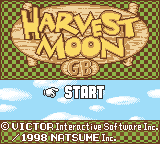
Farming sims have come a long way since the days of Harvest Moon on the Super NES and Game Boy—thanks in large part to Stardew Valley’s enormous success—but it’s amazing how much of the core experience has remained the same, and exists here in portable form. This is… Harvest Moon on the Game Boy, and it’s actually pretty darn good.
Graphically, it’s one of the most pleasing Game Boy/Game Boy Colour games available, featuring large, charming sprites and detailed environments. It’s incredible to look at this game, and match it up to some of the early gen Game Boy titles like Super Mario Land. It doesn’t even feel like the same system, and the way they’ve managed to convey detail, warmth, and personality with such limited graphical tools is a marvel.
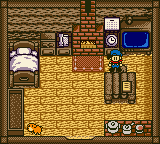
The game starts off a little confusingly—I had no idea what I was even supposed to do once I gained control of my character, and had to consult a walkthrough. But, once I got my feet under me, I was impressed to find all the things people love about Harvest Moon are intact and enjoyable in this portable adventure.
Harvest Moon GB was released in North America by Natsume for the Game Boy and Game Boy Color in 1998, and re-released on the 3DS Virtual Console in 2013.Recommended Read—Legends & Lattes by Travis Baldree
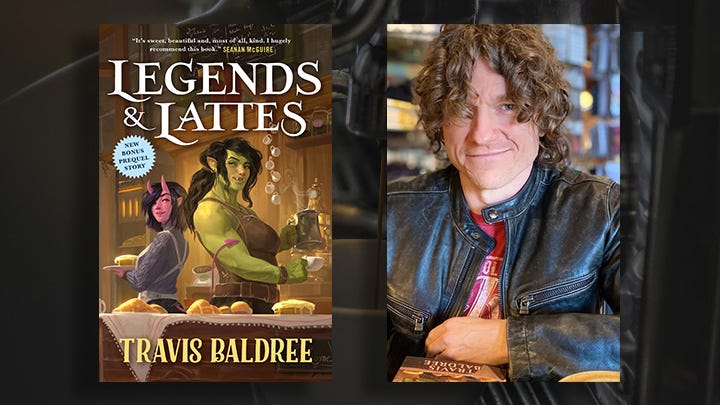
You ever sat in the din of a coffee shop, hand wrapped around a cold cuppa, just enjoying the moment? Rain drums outside, friends laugh, the waft of fresh baked cinnamon buns drifts from the kitchen, your favourite book’s dogeared on the table in front of you. You know that feeling?
Travis Baldree’s wrapped that up in the perfect book, and delivered what’s sure to be the coziest, more restorative book you’ll read this year. When grizzled orcish adventurer Viv opens a coffee shop, she hopes to find success, but ends up finding much, much more. Splendid doesn’t even begin to describe what Baldree’s created in Legends & Lattes. I need more. Now.
Get Legends & Lattes by Travis Baldree
Quest Markers
Quest Markers is a collection of the coolest stuff I’ve read around the web lately.- What It Takes to Make a Kinder, Gentler Video Game (Wired)
- Playing ‘Tunic’ Reminds Me How to Approach Sickness and Recovery (Catapult)
- Shelf Life: N.K. Jemisin (Elle)
- We Need To Start Holding Japanese RPGs To Higher Standards (Kotaku)
- Review: Small stakes: Travis Baldree's Legends & Lattes is a delightful fantasy about coffee and community (Transfer Orbit)
- Video Games Are Giving Up On The Idea That We Can Save The World (Kotaku)
- Sailor Moon meets Shakespeare: the design philosophies of magic girl RPG This Way Madness Lies (Game Developer)
- YouTube: God of War Ragnarök - PS5 vs PS4 vs PS4 Pro - The Complete Cross-Gen Comparison (Digital Foundry)
- I Love How The Wheel of Time TV Series Commits to Character Growth (Tor.com)
- Pentiment May Be the Best New Game You’ve Never Heard Of (Wired)
- Tactics Ogre: Reborn manages to be both timeless and dated (Polygon)
- Jillian Tamaki's picture book They Say Blue uses colour to explore the world through a child's eyes (CBC Books)
- Unsettling Futures: Is SF bad at tech skepticism? (Unsettling Futures)
- The school of hard crashes: Pokémon Scarlet and Violet Review (IGN)
- The Future Of Ryu Ga Gotoku Studio (Game Informer)
End Step
From cozy books to relaxing games, collective bargaining to discovering long lost classic JRPGs, this issue is all about taking care of yourself and those around you. Enjoy that coffee, sink into your favourite game, and fight for your right to party.
Support
There are lots of ways to support Astrolabe and my other work. Check ‘em out!
Keep In Touch
Enjoy Astrolabe? Want more SFF and retro gaming goodies? You can find me on Twitter and my website.
Credits
Astrolabe banner photo by Shot by Cerqueira on Unsplash
Despite contentious negotiations in mid-2022 between the Vox Union and Polygon’s parent company Vox, the staff working on this piece had full support to create this guide. “My editors and Polygon's leadership have been really supportive and helped champion the project,” Nicole Carpenter said. “It wouldn't have been possible to put so much time into this without that.” ↩

